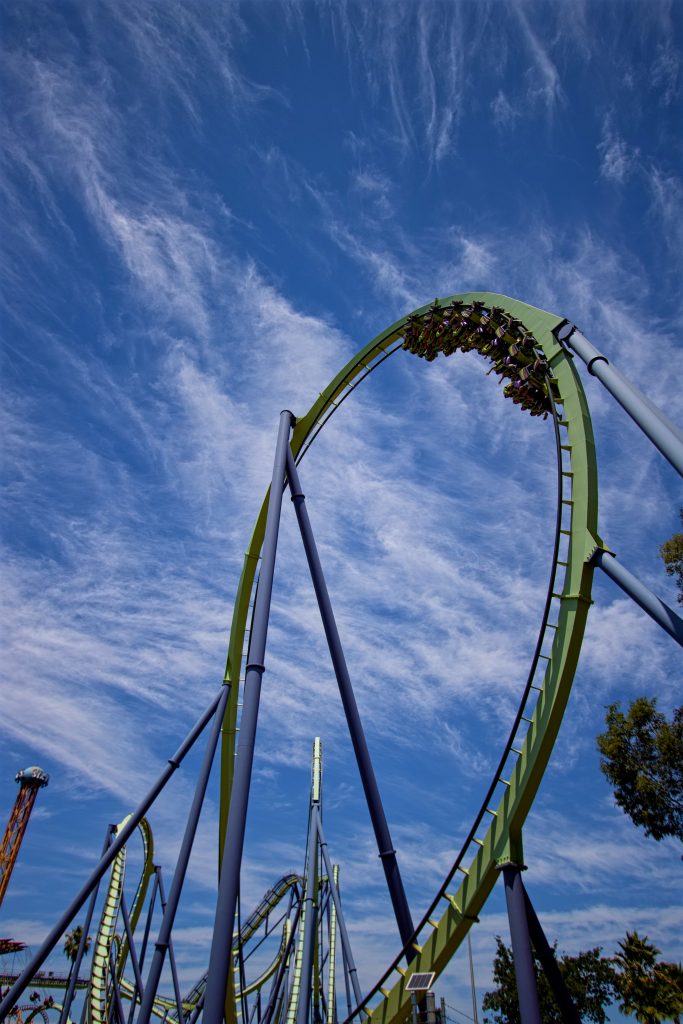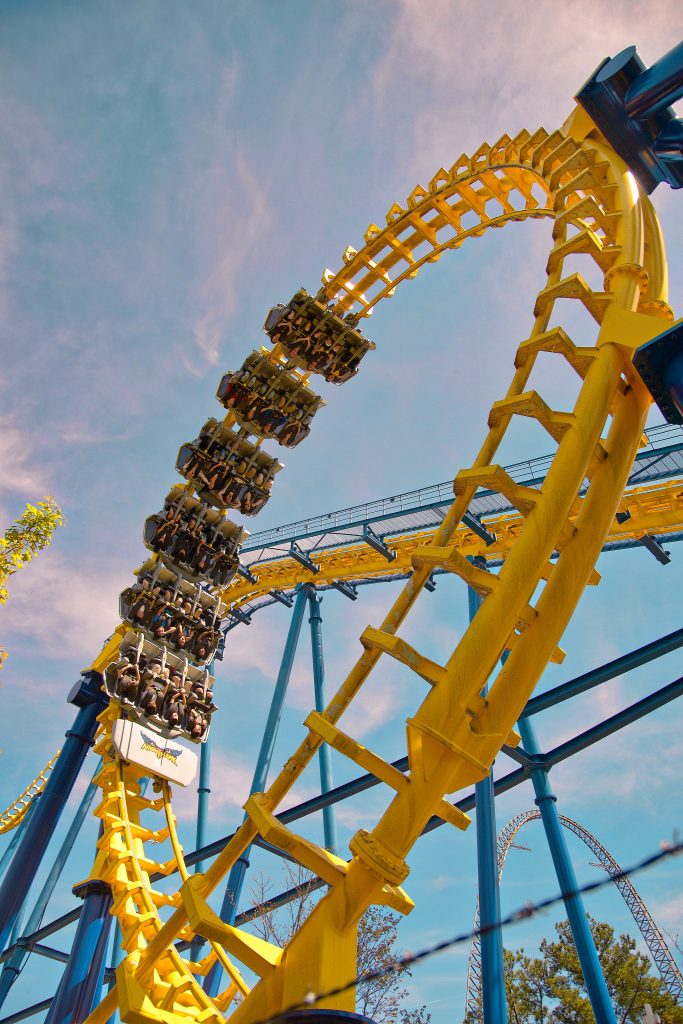Paramount Park’s 13 year foray into the theme park business resulted in a significant number of successes and industry oddities. The application of Paramount theming in existing regional parks gave us two significant B&M Top Gun inverts and the world’s first major linear induction motor launch coaster, Flight of Fear. However their tendency to experiment and take additions in different directions also resulted in a string of failures and disappointments. Kings Dominion opened the late Volcano, The Blast Coaster in 1998, a prototype Intamin inverted catapult coaster that never seemed to run reliably throughout its 20 years at the park, and the ill-fated prototype air launch coaster Hypersonic XLC in 2001. Carowinds opened a Setpoint suspended water coaster in 2000 called Flying Super Saturator which lasted less than 10 years. Canada’s Wonderland still has an odd collection of mid-size coasters for the world’s most popular regional park including 1995’s SLC Top Gun and 2004’s Zamperla flyer Tomb Raider, The Ride. The chain’s flagship, Kings Island, received one of the most notorious failures of them all, 2000’s wooden hyper coaster, Son of Beast. That same year the chain would add a unique prototype to Great America, the world’s first major flying coaster, Stealth.
– In the past, many of our images have been posted, featured, and shared on forums, social media platforms and websites around the web. We work hard to provide the coverage that we do, and we encourage our audience to share our content and use our images, BUT ONLY IF proper credit is given to thecoasterkings.com. Thank you! –
This article aligns with a special podcast mini-episode! Click the logo below to listen to the podcast!

Paramount Parks was not alone in its ambitious additions during this era. 2000 was the height of the second coaster wars. Six Flags and Cedar Fair went head to head with record breaking coasters, Goliath at Magic Mountain and Millenium Force at Cedar Point respectively. Six Flags was at the height of their rapid growth unveiling large scale additions at almost every park including two roller coasters for Six Flags Marine World, the Zierer family coaster Cobra and B&M floorless Medusa. For Stealth Paramount turned to Dutch Manufacturer Vekoma, with whom they had successfully opened two invertigo models.
Stealth would be a big step for Vekoma. Known for their use of Arrow’s tubular track design and then creating a cheaper alternative to the B&M inverted coaster this would be the first time the company truly debuted a world’s first. Dubbed the “flying dutchman” the first generation Vekoma flying coaster utilizes the company’s familiar tubular steel track design but with unique “lay down” cars. These cars start riders in a sitting position in the station and then tilt the riders backwards until they lock in a lay back position. After climbing the lift hill in this position a half-roll dubbed a “lie to fly” puts riders in the flying position. The mechanics of a train with cars that change position proved one of the Flying Dutchman’s biggest challenges. Stealth was built with only one loading platform but the cumbersome restraints and the tilting process added significantly to the coaster’s dispatch times. Vekoma would attempt to remedy this in later installations by adding a second loading platform but Stealth was left with a relatively low capacity for a major attraction. As a prototype, Stealth was also mired with mechanical issues and downtime. Problems with reliability further contributed to the coasters capacity leading to even longer lines.

Stealth proved to be very popular and received significant media attention for the unique experience it offered. While popular with guests it was hard not to compare it to the more reliable and thrilling Medusa at nearby Six Flags Marine World. At the end of the day Stealth offered a unique experience but its awkward trains and layout made its reception among enthusiasts to be mixed. Paramount was also displeased with its performance. Costing $17 million dollars, Stealth continued to have reliability issues while not offering the ridership the park was hoping to bring in. At the end of the 2003 season Paramount’s Great America chose to close the attraction and it was relocated to the then less visited Paramount’s Carowinds. The relocated coaster opened in 2004 as BORG Assimilator. In its place Great America opened a small Boomerang Bay waterpark addition. A conscious decision was made that smaller family-orientated investments made more sense for the Santa Clara park. Stealth would be the last major thrill coaster Great America would receive until 2013’s Gold Striker. In 2018 Cedar Fair would bring another groundbreaking coaster to the park when Railblazer opened as one of the first single-rail coasters in the world. 2021 promises to be the year that Stealth’s disappointing Boomerang Bay water-park replacement is expanded into the renamed South Bay Shores. Cedar Fair has given California’s Great America a mix of family and thrill attractions that the park has sorely needed since Stealth’s departure.

Paramount had intended to install two additional Vekoma Flying Dutchman coasters at other parks but opted out of this purchase. Six Flags chose to buy both. X-Flight at Ohio’s Six Flags Worlds of Adventure and Batwing at Six Flags America both opened in 2001. Despite its groundbreaking design Vekoma was unable to sell any additional Flying Dutchman coasters. Batwing and the Borg Assimilator(now renamed Nighthawk) remain the only examples of this groundbreaking coaster design. In a reversal of the inverted coaster B&M would open up their version of a flying coaster in 2002 with Alton Tower’s Air. B&M’s flying model has proven more successful with 11 installations worldwide. Vekoma would try and modify the design with their 2009 Stingray model. However, only one was ever constructed at China’s Giant Wheel Park of Suzhou and closed with the park in 2018. In 2020 Vekoma debuted a radically reimagined flying concept at Germany’s Phantasialand with F.L.Y.. With F.L.Y. Vekoma totally reconfigured the loading process by creating a rotating car system which allows for comfortable loading while the track is perpendicular to the loading platform. This new design also allows for rotation into the flying position while the coaster is in motion. F.L.Y. has opened to solid reviews and debuted as the world’s longest and first launched flying coaster. Only time will tell if the third time’s the charm for Vekoma’s flying coasters.
Next week we return to the thrill capital of the west coast for the last installment of Lost Coasters of California. In 2001 Six Flags would turn to Vekoma to bring another ambitious coaster to their parks. Vekoma would again push themselves, transforming their invertigo model into the tallest coaster design they ever constructed. Join me for the final part of Lost Coasters of California, Deja Vu.



OMG, you misspelled Millennium!! ;-0